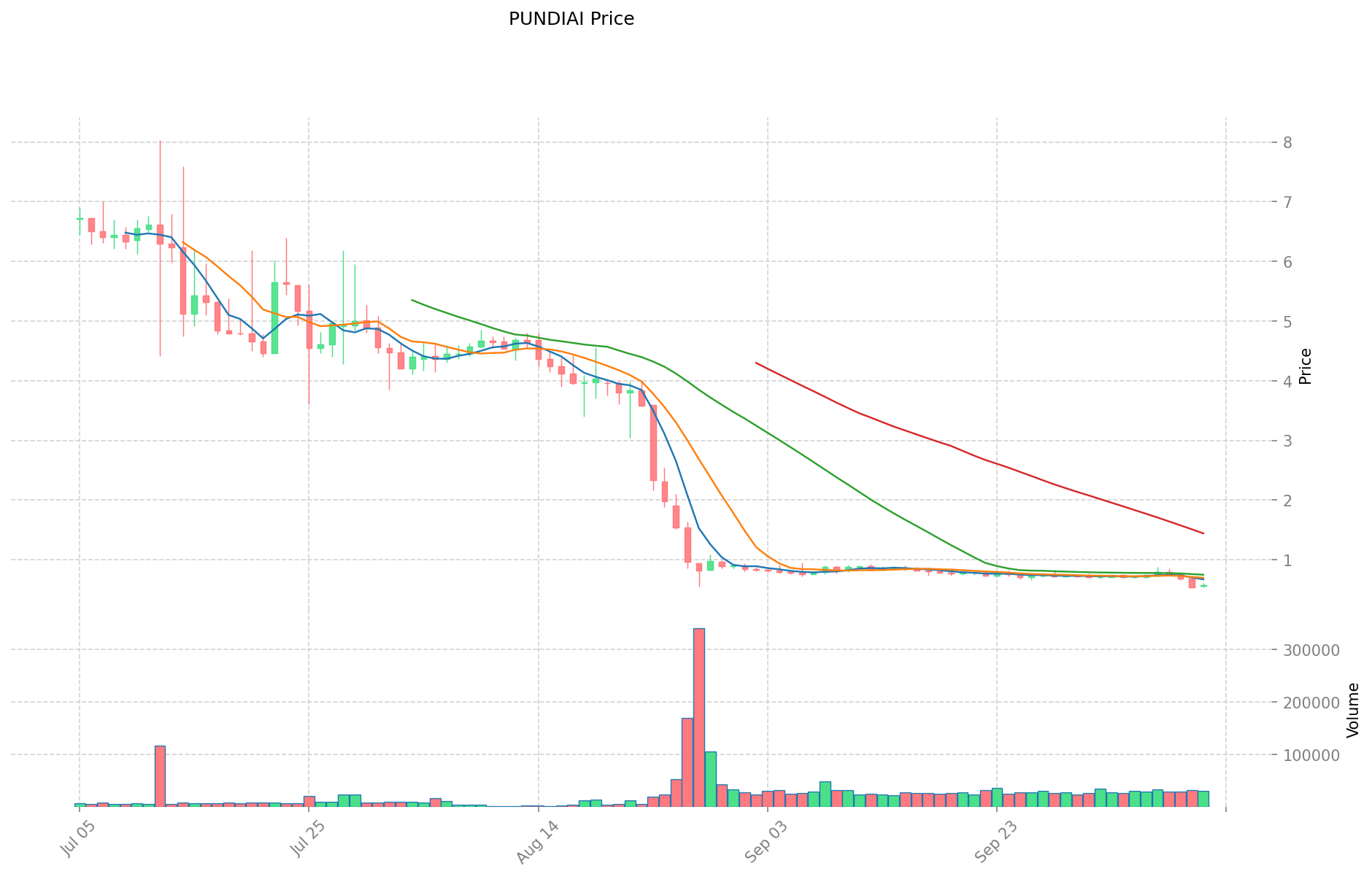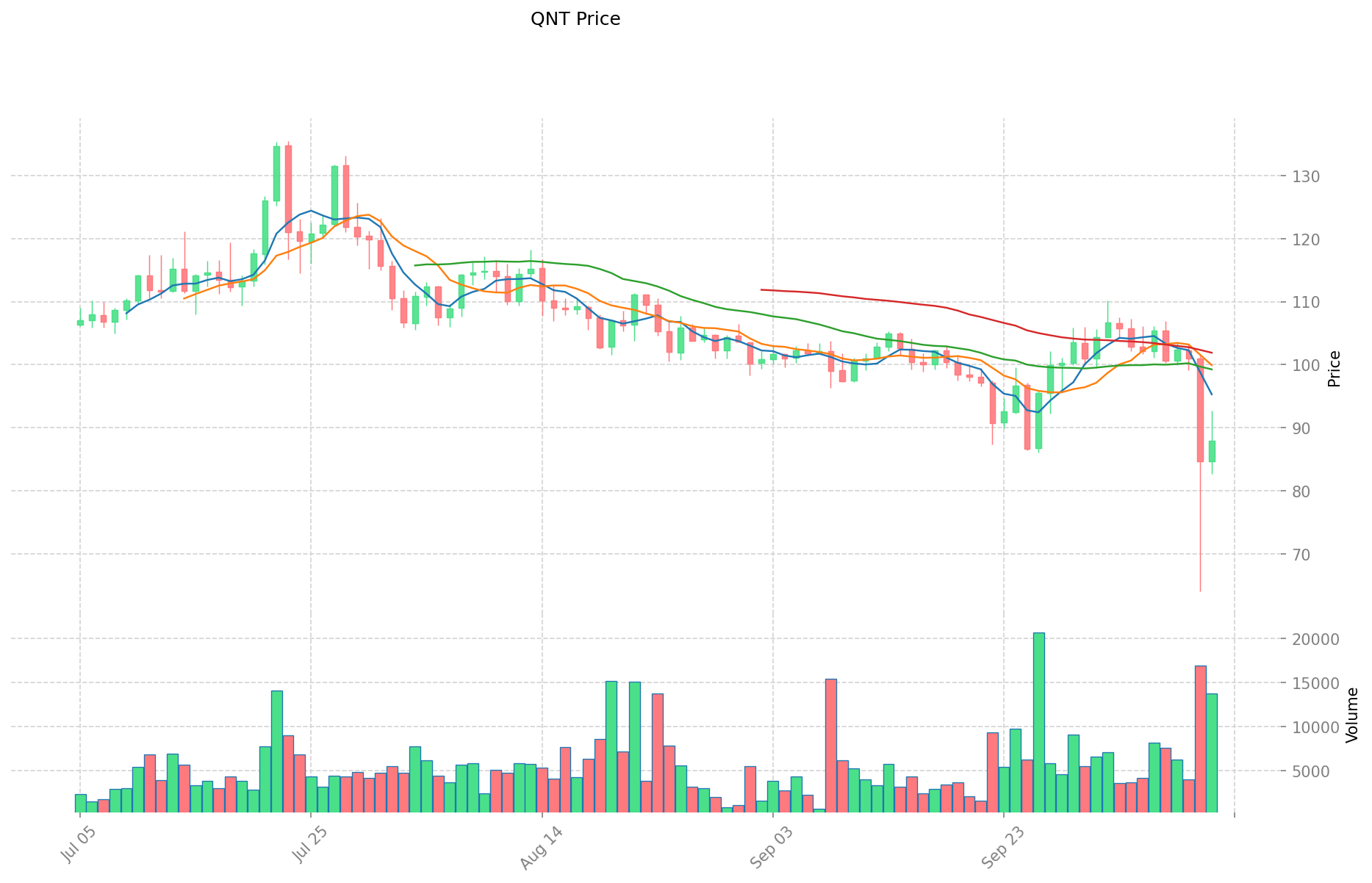PUNDIAI ve QNT: Kurumsal Entegrasyon İçin İki Yenilikçi Blockchain Çözümünün Karşılaştırılması

Giriş: PUNDIAI ile QNT Yatırımlarının Karşılaştırması
Kripto para piyasasında PUNDIAI ile QNT’nin karşılaştırılması, yatırımcılar açısından sürekli gündemdeki bir başlık olmuştur. Bu iki varlık, piyasa değeri sıralaması, kullanım alanları ve fiyat performansında belirgin farklılıklar sergilemekte ve kripto varlık ekosisteminde farklı konumlarda yer almaktadır.
Pundi AI (PUNDIAI): Lansmanından bu yana, kullanıcıların yapay zekâ verilerini fikri mülkiyet olarak katkıda bulunup, güvence altına almalarına ve yönetmelerine olanak tanıyarak piyasa tarafından tanınmıştır.
Quant (QNT): 2018’de piyasaya sunulan QNT, küresel blockchain işletim sistemi Overledger ile birlikte çalışabilirliği mümkün kılarak kurumsal inovasyon ve blockchain benimsenmesinde lider bir konum kazanmıştır.
Bu makalede, PUNDIAI ile QNT’nin yatırım değerleri kapsamlı biçimde analiz edilerek; geçmiş fiyat hareketleri, arz mekanizmaları, kurumsal adaptasyon, teknolojik ekosistemler ve gelecek projeksiyonları masaya yatırılıp yatırımcıların en çok merak ettiği soruya yanıt aranacaktır:
"Şu anda hangisi daha cazip bir alım?"
I. Geçmiş Fiyat Karşılaştırması ve Mevcut Piyasa Durumu
PUNDIAI (Coin A) ve QNT (Coin B) Tarihsel Fiyat Trendleri
- 2025: PUNDIAI, 17 Mayıs 2025’te 18,39 $ ile tüm zamanların en yüksek seviyesine ulaştı. Bu artış, projede yaşanan önemli gelişmeler veya piyasa ivmesiyle ilişkili olabilir.
- 2021: QNT, 11 Eylül 2021’de 427,42 $ ile zirve yaptı; bu yükseliş muhtemelen büyük ortaklıklar veya ağ güncellemelerinin etkisiyle gerçekleşti.
- Kıyaslama: Son piyasa döngüsünde PUNDIAI, 18,39 $’dan 0,54 $’a gerilerken; QNT daha stabil bir seyir izledi ve şu anda 88,00 $ seviyesinde, tüm zamanların en düşük seviyesi olan 0,22 $’ın epey üzerinde bulunuyor.
Güncel Piyasa Durumu (12 Ekim 2025)
- PUNDIAI anlık fiyatı: 0,5799 $
- QNT anlık fiyatı: 88,00 $
- 24 saatlik işlem hacmi: 18.278,63 $ (PUNDIAI) – 1.236.191,92 $ (QNT)
- Piyasa Duyarlılık Endeksi (Korku & Açgözlülük): 27 (Korku)
Canlı fiyatları görmek için tıklayın:
- PUNDIAI anlık fiyatı için Piyasa Fiyatı
- QNT anlık fiyatı için Piyasa Fiyatı


II. PUNDIAI ile QNT Yatırım Değerini Etkileyen Temel Faktörler
Arz Mekanizması (Tokenomik) Karşılaştırması
- PUNDIAI: Sabit arz modeli
- QNT: Token yakmalı deflasyonist model
- 📌 Tarihsel olarak, sınırlı arzlı token’lar piyasa döngülerinde genellikle daha fazla fiyat dalgalanması gösterirken; deflasyonist modeller uzun vadede daha güçlü fiyat artışı kaydedebiliyor.
Kurumsal Benimseme ve Piyasa Uygulamaları
- Kurumsal portföyler: QNT, kurumsal odaklı birlikte çalışabilirlik çözümleriyle daha fazla kurumsal ilgi çekiyor
- Kurumsal adaptasyon: QNT, Overledger teknolojisi sayesinde sınır ötesi ödemeler ve mutabakat sistemlerinde güçlü konuma sahip
- Düzenleyici bakış: Önde gelen finans merkezleri, QNT’nin kurumsal blockchain çözümlerine, AI tabanlı token’lara kıyasla daha olumlu bir düzenleyici yaklaşım sergiliyor
Teknolojik Gelişim ve Ekosistem Oluşumu
- PUNDIAI Teknik Güncellemeleri: Blockchain altyapısı ile yapay zekâ entegrasyonu
- QNT Teknik Gelişim: Blockchain’ler arası uyumluluk için Overledger Network’ün sürekli geliştirilmesi
- Ekosistem karşılaştırması: QNT, kurumsal ödeme çözümlerinde güçlü; PUNDIAI ise yapay zekâ destekli DeFi çözümlerine odaklanıyor
Makroekonomik ve Piyasa Döngüleri
- Enflasyonist ortamda performans: QNT, kurumsal kullanımı sayesinde enflasyona karşı daha dirençli
- Makro para politikası: Her iki token da faiz değişikliklerine duyarlı; QNT, sıkılaşma dönemlerinde daha dayanıklı bir performans sergilemiştir
- Jeopolitik etkiler: QNT, finansal sistemler arasında birlikte çalışabilirlik odağı sayesinde artan sınır ötesi işlem taleplerinden daha fazla fayda sağlıyor
III. 2025-2030 Fiyat Tahmini: PUNDIAI ile QNT
Kısa Vadeli Tahmin (2025)
- PUNDIAI: Temkinli 0,452166 $ – 0,5797 $ | İyimser 0,5797 $ – 0,863753 $
- QNT: Temkinli 77,3696 $ – 87,92 $ | İyimser 87,92 $ – 120,4504 $
Orta Vadeli Tahmin (2027)
- PUNDIAI, bir büyüme evresine girerek fiyatların 0,5944139454 $ – 0,962783151 $ aralığında seyretmesi bekleniyor
- QNT, istikrarlı bir büyüme sürecine girerek fiyatların 85,5620955 $ – 126,63190134 $ aralığında olması öngörülüyor
- Temel itici güçler: Kurumsal sermaye girişi, ETF’ler, ekosistem gelişimi
Uzun Vadeli Tahmin (2030)
- PUNDIAI: Temel senaryo 1,274277511709812 $ – 1,771245741276639 $ | İyimser senaryo 1,771245741276639 $+
- QNT: Temel senaryo 152,324259211152 $ – 173,64965550071328 $ | İyimser senaryo 173,64965550071328 $+
Yasal Uyarı: Bu analiz, geçmiş verilere ve güncel piyasa eğilimlerine dayanmaktadır. Kripto para piyasaları oldukça oynak ve öngörülemezdir. Bu bilgiler yatırım tavsiyesi değildir. Yatırım kararı vermeden önce kendi araştırmanızı yapınız.
PUNDIAI:
| 年份 | 预测最高价 | 预测平均价格 | 预测最低价 | 涨跌幅 |
|---|---|---|---|---|
| 2025 | 0.863753 | 0.5797 | 0.452166 | 0 |
| 2026 | 0.95267898 | 0.7217265 | 0.50520855 | 24 |
| 2027 | 0.962783151 | 0.83720274 | 0.5944139454 | 44 |
| 2028 | 1.214990476425 | 0.8999929455 | 0.77399393313 | 55 |
| 2029 | 1.491063312457125 | 1.0574917109625 | 0.708519446344875 | 82 |
| 2030 | 1.771245741276639 | 1.274277511709812 | 1.08313588495334 | 119 |
QNT:
| 年份 | 预测最高价 | 预测平均价格 | 预测最低价 | 涨跌幅 |
|---|---|---|---|---|
| 2025 | 120.4504 | 87.92 | 77.3696 | 0 |
| 2026 | 123.980388 | 104.1852 | 78.1389 | 18 |
| 2027 | 126.63190134 | 114.082794 | 85.5620955 | 29 |
| 2028 | 149.2431111108 | 120.35734767 | 102.3037455195 | 36 |
| 2029 | 169.848289031904 | 134.8002293904 | 113.232192687936 | 53 |
| 2030 | 173.64965550071328 | 152.324259211152 | 117.28967959258704 | 73 |
IV. Yatırım Stratejileri Karşılaştırması: PUNDIAI ile QNT
Uzun Vadeli ve Kısa Vadeli Yatırım Stratejileri
- PUNDIAI: Yapay zekâ entegrasyonu ve DeFi potansiyeline odaklananlar için uygundur
- QNT: Kurumsal yaygınlık ve birlikte çalışabilirlik çözümlerini hedefleyenler için uygundur
Risk Yönetimi ve Varlık Dağılımı
- Temkinli yatırımcılar: PUNDIAI %20 – QNT %80
- Agresif yatırımcılar: PUNDIAI %40 – QNT %60
- Koruma araçları: Stablecoin tahsisi, opsiyonlar, döviz çeşitlendirmesi
V. Potansiyel Risk Karşılaştırması
Piyasa Riski
- PUNDIAI: Yapay zeka piyasasındaki trendler ve sınırlı arz nedeniyle yüksek oynaklık
- QNT: Kurumsal blockchain benimseme oranlarına duyarlılık
Teknik Risk
- PUNDIAI: Ölçeklenebilirlik ve ağ stabilitesi
- QNT: Geliştirme merkeziyeti ve güvenlik açıkları
Düzenleyici Risk
- Küresel düzenleyici politikalar, AI odaklı token’lar ile kurumsal blockchain çözümleri üzerinde farklı etkiler yaratabilir
VI. Sonuç: Hangisi Daha Avantajlı Bir Alım?
📌 Yatırım Değeri Özeti:
- PUNDIAI’nin öne çıkan yanları: AI entegrasyonu ve yeni teknolojilerde hızlı büyüme potansiyeli
- QNT’nin öne çıkan yanları: Güçlü kurumsal benimseme ve köklü birlikte çalışabilirlik çözümleri
✅ Yatırım Tavsiyesi:
- Yeni yatırımcılar: Daha fazla istikrar için QNT’ye ağırlık verin
- Deneyimli yatırımcılar: Her iki token’ı da içeren, QNT ağırlıklı dengeli bir portföy tercih edin
- Kurumsal yatırımcılar: Kurumsal uygulamalar ve düzenleyici netlik nedeniyle QNT odaklı hareket edin
⚠️ Risk Uyarısı: Kripto para piyasaları yüksek oynaklığa sahiptir. Bu içerik yatırım tavsiyesi değildir. None
VII. SSS
S1: PUNDIAI ile QNT arasındaki temel farklar nedir? C: PUNDIAI, blockchain ve yapay zekâ entegrasyonuna odaklanırken; QNT, kurumsal blockchain birlikte çalışabilirlik çözümlerinde uzmanlaşmıştır. QNT, kurumsal benimsemede güçlü performans gösterirken PUNDIAI, AI odaklı DeFi çözümlerine yönelmiştir.
S2: Hangi token daha fazla fiyat istikrarı gösterdi? C: QNT, halen tüm zamanların en düşük seviyesinin çok üzerinde işlem görerek daha fazla fiyat istikrarı sunmuştur. PUNDIAI ise daha belirgin fiyat dalgalanmaları yaşamıştır.
S3: PUNDIAI ile QNT’nin arz mekanizmaları arasında ne fark var? C: PUNDIAI sabit arz modelini kullanırken, QNT token yakmalı deflasyonist bir model uygular.
S4: Hangisi uzun vadeli yatırım için daha uygun görülüyor? C: QNT, kurumsal benimsemesi, birlikte çalışabilirlik çözümleri ve güçlü kurumsal ilgisiyle uzun vadeli yatırım için genellikle daha uygun kabul edilmektedir.
S5: PUNDIAI ve QNT yatırımlarında öne çıkan riskler neler? C: PUNDIAI, AI entegrasyonuna bağlı yüksek oynaklık ve teknik zorluklarla karşı karşıya. QNT’de ise kurumsal blockchain benimseme oranları ve geliştirme merkeziyeti başlıca risklerdir.
S6: Düzenleyici faktörler bu token’ları nasıl farklı etkileyebilir? C: QNT, kurumsal odaklı yapısı sayesinde daha olumlu bir düzenleyici perspektiften faydalanabilirken, PUNDIAI bazı ülkelerde AI tabanlı token olması sebebiyle daha fazla denetime uğrayabilir.
S7: Temkinli yatırımcılar için hangi dağılım önerilir? C: Temkinli yatırımcılar için önerilen dağılım, %20 PUNDIAI ve %80 QNT olup, kurumsal temeli güçlü QNT önceliklendirilmektedir.

INFINIT (IN) iyi bir yatırım mı?: Yeni dijital varlığın piyasa potansiyeli ve risklerinin analizi

Griffin AI (GAIN) iyi bir yatırım mı?: Bu yeni nesil yapay zeka hissesinin potansiyelini ve risklerini değerlendirme

BCUT ve SNX: İçerik üreticilerine yönelik iki önde gelen video düzenleme platformunun karşılaştırmalı analizi

LVVA vs ATOM: Yaratıcı Sektörde Dijital Varlık Yönetiminde Üstünlük Yarışı

Creator Bid (BID) İyi Bir Yatırım mı?: Creator Economy Token'ında Potansiyel Getiri ve Riskler Üzerine Analiz

AIC ve AVAX: Akıllı Sözleşme Geliştirme için İki Blockchain Platformunun Karşılaştırılması

Bitcoin fiyatı pound cinsinden, traderların şimdi bilmesi gerekenler.

Kripto para piyasasında Pivot Noktası ticaret stratejilerini ustalıkla kullanmak

Yeni Madenciler İçin En İyi Kripto Madencilik Platformları

Blockchain’de Kriptografik Hashleme’nin Temelleri: Kapsamlı Bir Rehber

Ethereum fiyatı düşüşte, bu uzun vadeli long aç fırsatı olabilir.





